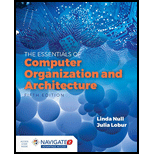
Concept explainers
The RTN for “StoreI” instruction:
RTN is the register transfer notation which is used to represents the behavior of micro operations with the use of symbols. The “StoreI” instruction used to store the particular value in register. The register transfer notation (RTN) used to describe the micro operations of the instruction.
The RTN for “StoreI” as per given instruction:
Where,
- Memory Address Register (MAR)
- Memory Buffer Register (MBR)
- Program counter(PC)
- Instruction register(IR)
- Accumulator register (AC)
Explanation of Solution
Control signals for given “StoreI” instruction:
The data path control signals for each register as given below:
| Register | Memory | MAR | PC | MBR | AC | IN | Out | IR |
| Signals | 000 | 001 | 010 | 011 | 100 | 101 | 110 | 111 |
|
P2 P1 P0 (Read) P5 P4 P3(Write) |
The control signals are varying based on read and write operations. The register values may vary in this. The RTN for “StoreI” instruction with its signals is as follows:
Here,
- “MR” is memory read that enables the control line at time “T1” and “T2”.
- “LALT” is loading the values from the data wires inn registers like MBR, MAR, IR, and AC at time “T1” and “T2”.
- At time “T0” all other signals except “P1”, “P3”, and “T0” are low. The signal “P1” allows reading from PC and “P3” writing to MAR.
- At time “T1” all other signals except “P3”, “P4”, and “T1” are low. Repeat the process for the rest of clock times.
- The last instruction occurs at “T5” when the timing signals are reset to 0.
The control signals contain “1” for each instruction step with “JumpI” instruction is as follows:
| Step | RTN | Time | P5 | P4 | P3 | P2 | P1 | P0 | CR | IncrPC | MR | MW | LALT |
| Fetch | MAR←PC | T0 | 0 | 0 | 1 | 0 | 1 | 0 | 0 | 0 | 0 | 0 | 0 |
| IR←M[MAR] | T1 | 1 | 1 | 1 | 0 | 0 | 1 | 0 | 0 | 1 | 0 | 1 | |
| Decode IR[15-12] | PC←PC+1 | T2 | 0 | 1 | 0 | 0 | 1 | 0 | 0 | 1 | 0 | 0 | 0 |
| Get operand | MAR←IR[11-0] | T3 | 0 | 0 | 1 | 1 | 1 | 1 | 0 | 0 | 0 | 0 | 0 |
| Execute | MBR←M[MAR] | T4 | 0 | 1 | 1 | 0 | 0 | 0 | 0 | 0 | 1 | 0 | 1 |
| MAR←MBR | T5 | 0 | 0 | 1 | 0 | 1 | 1 | 0 | 0 | 0 | 0 | 0 | |
| MBR←AC | T6 | 0 | 1 | 1 | 1 | 0 | 0 | 0 | 0 | 0 | 0 | 1 | |
| M[MAR]←MBR | T7 | 0 | 0 | 0 | 0 | 1 | 1 | 0 | 0 | 0 | 1 | 0 | |
| PC←MBR | T8 | 0 | 1 | 0 | 0 | 1 | 1 | 1 | 0 | 0 | 0 | 1 |
Want to see more full solutions like this?
Chapter 4 Solutions
EBK ESSENTIALS OF COMPUTER ORGANIZATION
 Database System ConceptsComputer ScienceISBN:9780078022159Author:Abraham Silberschatz Professor, Henry F. Korth, S. SudarshanPublisher:McGraw-Hill Education
Database System ConceptsComputer ScienceISBN:9780078022159Author:Abraham Silberschatz Professor, Henry F. Korth, S. SudarshanPublisher:McGraw-Hill Education Starting Out with Python (4th Edition)Computer ScienceISBN:9780134444321Author:Tony GaddisPublisher:PEARSON
Starting Out with Python (4th Edition)Computer ScienceISBN:9780134444321Author:Tony GaddisPublisher:PEARSON Digital Fundamentals (11th Edition)Computer ScienceISBN:9780132737968Author:Thomas L. FloydPublisher:PEARSON
Digital Fundamentals (11th Edition)Computer ScienceISBN:9780132737968Author:Thomas L. FloydPublisher:PEARSON C How to Program (8th Edition)Computer ScienceISBN:9780133976892Author:Paul J. Deitel, Harvey DeitelPublisher:PEARSON
C How to Program (8th Edition)Computer ScienceISBN:9780133976892Author:Paul J. Deitel, Harvey DeitelPublisher:PEARSON Database Systems: Design, Implementation, & Manag...Computer ScienceISBN:9781337627900Author:Carlos Coronel, Steven MorrisPublisher:Cengage Learning
Database Systems: Design, Implementation, & Manag...Computer ScienceISBN:9781337627900Author:Carlos Coronel, Steven MorrisPublisher:Cengage Learning Programmable Logic ControllersComputer ScienceISBN:9780073373843Author:Frank D. PetruzellaPublisher:McGraw-Hill Education
Programmable Logic ControllersComputer ScienceISBN:9780073373843Author:Frank D. PetruzellaPublisher:McGraw-Hill Education





